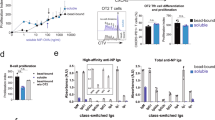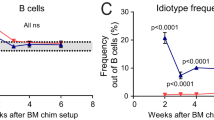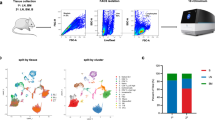Abstract
ALTHOUGH the T-cell antigen receptor has been shown to be as highly specific for antigen as the immunoglobulin receptor of B cells, considerable evidence suggests that genes other than those which code for immunoglobulins are involved in the recognition of antigen by T cells. Research in this area has centred on the role of gene products of the major histocompatibility complex (MHC), in particular of the I region of the H–2 complex of mice, in the antigen-specific receptor of T cells1–3. Other evidence has suggested that the specificity of T cells is determined by the simultaneous recognition of antigen and MHC cell-surface components. The best evidence for this comes from experiments with mice in which T-cell cytotoxic effectors specifically raised to the H–Y (ref. 4) or other minor histocompatibility antigens5, viral antigens6 or the hapten trinitrophenol (TNP)7 were shown to recognise simultaneously both the antigen and the products of the D or K locus of H–2 expressed on the target cells. Investigations of the role of MHC gene products in the antigen–mediated interaction of T cells with B cells or macrophages (MΦ) can be interpreted similarly1,8–15. We present here evidence that in the mouse, helper T cells primed with the antigen, keyhole limpet haemocyanin (KLH), bound to the surface of MΦ, simultaneously recognise KLH and genetically controlled surface components of the MΦ. The rationale for our approch was as follows. In F1 animals whose parents differ at loci controlling surface components (for example, H–2, Mls), if T cells could be primed with antigen bound to MΦ from one or the other parent, they should then cooperate preferentially with parental B cells and MΦ of the type used for priming.
This is a preview of subscription content, access via your institution
Access options
Subscribe to this journal
Receive 51 print issues and online access
$199.00 per year
only $3.90 per issue
Buy this article
- Purchase on Springer Link
- Instant access to full article PDF
Prices may be subject to local taxes which are calculated during checkout
Similar content being viewed by others
References
The Role of Products of the Histocompatibility Gene Complex in Immune Responses (edit. by Katz, D. H., and Benacerraf, B.), (Academic, New York, 1976); Benacerraf, B., and Katz, D. H., Adv. Cancer Res., 21, 121–173 (1975).
Hämmerling, G. J., and McDevitt, H. O., J. Immun., 112, 1734–1740 (1974); J. exp. Med., 140, 1180–1188 (1974).
Munro, A. J., and Taussig, M. J., Nature, 256, 103–106 (1975); Taussig, M. J., Munro, A. J., Campbell, R., David, C. S., and Staines, N. A., J. exp. Med., 142, 694–700 (1975).
Gordon, R. D., Simpson, E., and Samelson, L. E., J. exp. Med., 142, 1108–1120 (1975).
Bevan, M. J., J. exp. Med., 142, 1349–1364 (1975).
Zinkernagel, R. M., and Doherty, P. C., J. exp. Med., 141, 1427–1436 (1975).
Shearer, G. M., Rehn, T. G., and Garbarino, C. A., J. exp. Med., 141, 1348–1364 (1975).
Katz, D. H., Graves, M., Dorf, M. E., Dinuzio, H., and Benacerraf, B., J. exp. Med., 141, 263–268 (1975); Katz, D. H., Hanaoka, T., Dorf, M. E., and Benacerraf, B., J. exp. Med., 138, 734–739 (1973).
Bechtol, K. B., Freed, J. H., Herzenberg, L. A., and McDevitt, H. O., J. exp. Med., 140, 1660–1675 (1974).
Von Boehmer, H., Hardson, L., and Sprent, J., J. exp. Med., 142, 989–997 (1975).
Heber-Katz, E., and Wilson, D. B., J. exp. Med., 142, 914–935 (1975).
Rosenthal, A. S., and Shevach, E. M., J. exp. Med., 138, 1194–1212 (1973); Shevach, E. M., and Rosenthal, A. S., J. exp. Med., 138, 1213–1229, (1973).
Erb, P., and Feldmann, M., J. exp. Med., 142, 460–472 (1975); Eur. J. Immun., 5, 759–766 (1975).
Miller, J. F. A. P., Vadas, M. A., Whitelaw, A., and Gamble, J., Proc. natn. Acad. Sci. U.S.A., 72, 5095–5098 (1975).
Waldmann, H., Pope, H., and Munro, A. J., Nature, 258, 728–730 (1975).
Greaves, M. F., and Brown, G. J., J. Immun., 112, 420–423 (1974).
Jacobs, D., and Morrison, D. J., J. Immun., 114, 360–364 (1975).
Kappler, J. W., and Marrack(Hunter), P. C., Cell. Immun., 18, 9–20 (1975).
Mishell, R. I., and Dutton, R. W., J. exp. Med., 126, 423–442 (1967); Kettman, J. R., and Dutton, R. W., Proc. natn. Acad. Sci. U.S.A., 68, 699–703 (1971).
Author information
Authors and Affiliations
Rights and permissions
About this article
Cite this article
KAPPLER, J., MARRACK, P. Helper T cells recognize antigen and macrophage surface components simultaneously. Nature 262, 797–799 (1976). https://doi.org/10.1038/262797a0
Received:
Accepted:
Published:
Issue Date:
DOI: https://doi.org/10.1038/262797a0
This article is cited by
-
Positive selection of CD4+ T cells mediated by MHC class ll-bearing stromal cell in the thymic cortex
Nature (1989)
-
Mammalian T-lymphocyte antigen receptor genes: genetic and nongenetic potential to generate variability
Human Genetics (1987)
-
Immunoglobulin-like nature of the α-chain of a human T-cell antigen/MHC receptor
Nature (1984)
-
Primary structure of human T-cell receptor α-chain
Nature (1984)
Comments
By submitting a comment you agree to abide by our Terms and Community Guidelines. If you find something abusive or that does not comply with our terms or guidelines please flag it as inappropriate.



